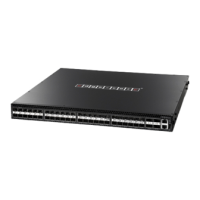Chapter 21
| VLAN Commands
Configuring IEEE 802.1Q Tunneling
– 591 –
Configuring IEEE 802.1Q Tunneling
IEEE 802.1Q tunneling (QinQ tunneling) uses a single Service Provider VLAN
(SPVLAN) for customers who have multiple VLANs. Customer VLAN IDs are
preserved and traffic from different customers is segregated within the service
provider’s network even when they use the same customer-specific VLAN IDs. QinQ
tunneling expands VLAN space by using a VLAN-in-VLAN hierarchy, preserving the
customer’s original tagged packets, and adding SPVLAN tags to each frame (also
called double tagging).
This section describes commands used to configure QinQ tunneling.
General Configuration Guidelines for QinQ
1. Configure the switch to QinQ mode (dot1q-tunnel system-tunnel-control).
2. Create a SPVLAN (vlan).
3. Configure the QinQ tunnel access port to dot1Q-tunnel access mode
(switchport dot1q-tunnel mode).
4. Set the Tag Protocol Identifier (TPID) value of the tunnel access port. This step is
required if the attached client is using a nonstandard 2-byte ethertype to
identify 802.1Q tagged frames. The standard ethertype value is 0x8100. (See
switchport dot1q-tunnel tpid.)
5. Configure the QinQ tunnel access port to join the SPVLAN as an untagged
member (switchport allowed vlan).
6. Configure the SPVLAN ID as the native VID on the QinQ tunnel access port
(switchport native vlan).
7. Configure the QinQ tunnel uplink port to dot1Q-tunnel uplink mode
(switchport dot1q-tunnel mode).
Table 109: 802.1Q Tunneling Commands
Command Function Mode
dot1q-tunnel
system-tunnel-control
Configures the switch to operate in normal mode or QinQ
mode
GC
switchport dot1q-tunnel
mode
Configures an interface as a QinQ tunnel port IC
switchport dot1q-tunnel
service match cvid
Creates a CVLAN to SPVLAN mapping entry IC
switchport dot1q-tunnel
tpid
Sets the Tag Protocol Identifier (TPID) value of a tunnel port IC
show dot1q-tunnel Displays the configuration of QinQ tunnel ports PE
show interfaces switchport Displays port QinQ operational status PE

